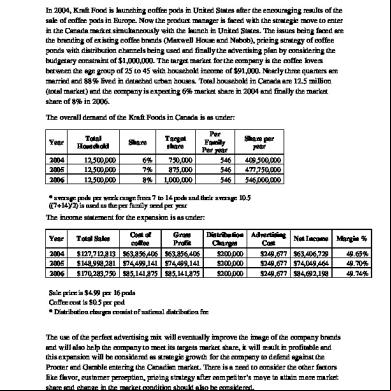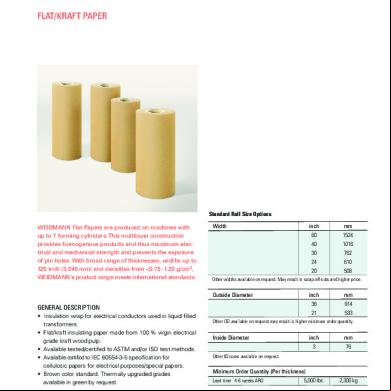Kraft 6d4b4e
This document was ed by and they confirmed that they have the permission to share it. If you are author or own the copyright of this book, please report to us by using this report form. Report 2z6p3t
Overview 5o1f4z
& View Kraft as PDF for free.
More details 6z3438
- Words: 381
- Pages: 1
Kraft Foods – The Coffee Pod Launch (A) In 2004, Kraft Food is launching coffee pods in United States after the encouraging results of the sale of coffee pods in Europe. Now the product manager is faced with the strategic move to enter in the Canada market simultaneously with the launch in United States. The issues being faced are the branding of existing coffee brands (Maxwell House and Nabob), pricing strategy of coffee ponds with distribution channels being used and finally the advertising plan by considering the budgetary constraint of $1,000,000. The target market for the company is the coffee lovers between the age group of 25 to 45 with household income of $91,000. Nearly three quarters are married and 88% lived in detached urban houses. Total household in Canada are 12.5 million (total market) and the company is expecting 6% market share in 2004 and finally the market share of 8% in 2006. The overall demand of the Kraft Foods in Canada is as under: Year 2004 2005 2006
Total Household 12,500,000 12,500,000 12,500,000
Share 6% 7% 8%
Target share 750,000 875,000 1,000,000
Per Family Per year 546 546 546
Share per year 409,500,000 477,750,000 546,000,000
* average pods per week range from 7 to 14 pods and their average 10.5 ((7+14)/2) is used as the per family need per year
The income statement for the expansion is as under: Cost of coffee
Gross Profit
Year
Total Sales
2004 2005 2006
$127,712,813 $63,856,406 $63,856,406 $148,998,281 $74,499,141 $74,499,141 $170,283,750 $85,141,875 $85,141,875
Distribution Charges $200,000 $200,000 $200,000
Advertising Cost
Net Income
Margin %
$249,677 $63,406,729 $249,677 $74,049,464 $249,677 $84,692,198
49.65% 49.70% 49.74%
Sale price is $4.99 per 16 pods Coffee cost is $0.5 per pod * Distribution charges consist of national distribution fee
The use of the perfect advertising mix will eventually improve the image of the company brands and will also help the company to meet its targets market share, it will result in profitable and this expansion will be considered as strategic growth for the company to defend against the Procter and Gamble entering the Canadian market. There is a need to consider the other factors like flavor, customer perception, pricing strategy after competitor’s move to attain more market share and change in the market condition should also be considered.
Total Household 12,500,000 12,500,000 12,500,000
Share 6% 7% 8%
Target share 750,000 875,000 1,000,000
Per Family Per year 546 546 546
Share per year 409,500,000 477,750,000 546,000,000
* average pods per week range from 7 to 14 pods and their average 10.5 ((7+14)/2) is used as the per family need per year
The income statement for the expansion is as under: Cost of coffee
Gross Profit
Year
Total Sales
2004 2005 2006
$127,712,813 $63,856,406 $63,856,406 $148,998,281 $74,499,141 $74,499,141 $170,283,750 $85,141,875 $85,141,875
Distribution Charges $200,000 $200,000 $200,000
Advertising Cost
Net Income
Margin %
$249,677 $63,406,729 $249,677 $74,049,464 $249,677 $84,692,198
49.65% 49.70% 49.74%
Sale price is $4.99 per 16 pods Coffee cost is $0.5 per pod * Distribution charges consist of national distribution fee
The use of the perfect advertising mix will eventually improve the image of the company brands and will also help the company to meet its targets market share, it will result in profitable and this expansion will be considered as strategic growth for the company to defend against the Procter and Gamble entering the Canadian market. There is a need to consider the other factors like flavor, customer perception, pricing strategy after competitor’s move to attain more market share and change in the market condition should also be considered.








